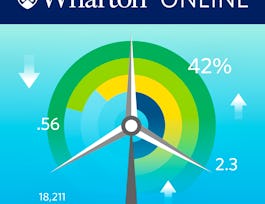In this course, you will explore the foundations upon which modern-day ESG was built, how market forces react to ESG, and ways to create and maintain value using ESG investment strategies. You will also learn about the five pathways of materiality, and how those interplay with or against ESG performance.


ESG Risks and Opportunities
This course is part of The Materiality of ESG Factors Specialization
Taught in English
Some content may not be translated

Instructor: Witold Henisz
22,166 already enrolled
Included with 
Course
(587 reviews)
96%
Details to know

Add to your LinkedIn profile
4 quizzes
Course
(587 reviews)
96%
See how employees at top companies are mastering in-demand skills

Build your subject-matter expertise
- Learn new concepts from industry experts
- Gain a foundational understanding of a subject or tool
- Develop job-relevant skills with hands-on projects
- Earn a shareable career certificate


Earn a career certificate
Add this credential to your LinkedIn profile, resume, or CV
Share it on social media and in your performance review

There are 4 modules in this course
In this module, you will be introduced to Environmental, Social and Governance (ESG) Factors and the many different pathways by which they impact financial value. You will learn about the importance of assessing stakeholder interest or salience in different ESG factors and how this varies across industries. You will also gain insight into the five pathways of materiality through which ESG factors impact revenues, costs, or productivity. Finally, you will examine the conditions under which stakeholders are expected to activate these pathways, highlighting the strategic and financial importance of stakeholder relations. By the end of this module, you will have learned how to discern which ESG pathways matter for you and your stakeholders, how to navigate the materiality map and the importance of stakeholder relations for shareholder value.
What's included
8 videos1 reading1 quiz
In this module, you will get an overview of the history of ESG Investing and review the past and present ways that investors have attempted to incorporate environmental, social, and governance factors into their strategies. You will also learn about the relationships between social pressure, corporate responses, and financial performance. Next, you will look at portfolio optimization and how to utilize ESG factors to maximize returns. Lastly, you will review various case studies that look at different investment strategies and their outcomes in terms of both ESG and financial performance. By the end of this module, you will understand the history of ESG investing, corporate engagement and responsibility, and the different ways ESG factors can be integrated into investment strategies.
What's included
8 videos1 reading1 quiz
In this module, you will learn about the importance of ESG data and how you can best integrate it into your financial analyses. Next, you will review different providers of data for ESG factors and learn how to assess this data despite the challenges of interpretability and subjectivity. Next, you will survey the tendency towards integrated reporting whereby firms embed ESG data inside their financial reports. Lastly, you will examine ESG data that focuses on the financial impacts on a firm’s stakeholders who may, in turn, create financial benefits or harm for the firm. By the end of this module, you will be better able to utilize ESG data, assess the differences in ESG data provider approaches, and determine how to quantify the environmental, social, and governance factors which impact a firm’s stakeholders.
What's included
6 videos1 reading1 quiz
In this module, you learn about the specific cost and revenue variances associated with ESG issues and how better stakeholder relations can mitigate some of these risks. You will also examine cases from Peru, Ghana, and Brazil, and assess how different ESG risk management strategies affected the performance of these projects. You will also review participatory stakeholder processes, external value at stake (EVAS), and integrated project management systems. Lastly, you will look at transformative ways to implement ESG risk assessments into a broader risk management framework to maximize expected corporate performance. By the end of this module, you will have identified best practices for creating a solid financial and risk management plan that incorporates ESG factors and will understand how to create a culture that is sensitive to ESG.
What's included
8 videos1 reading1 quiz
Instructor

Offered by
Recommended if you're interested in Finance

University of Pennsylvania

University of Pennsylvania

University of Pennsylvania

University of Pennsylvania
Why people choose Coursera for their career




Learner reviews
Showing 3 of 587
587 reviews
- 5 stars
72.68%
- 4 stars
20.57%
- 3 stars
4.72%
- 2 stars
1.18%
- 1 star
0.84%
New to Finance? Start here.

Open new doors with Coursera Plus
Unlimited access to 7,000+ world-class courses, hands-on projects, and job-ready certificate programs - all included in your subscription
Advance your career with an online degree
Earn a degree from world-class universities - 100% online
Join over 3,400 global companies that choose Coursera for Business
Upskill your employees to excel in the digital economy
Frequently asked questions
Access to lectures and assignments depends on your type of enrollment. If you take a course in audit mode, you will be able to see most course materials for free. To access graded assignments and to earn a Certificate, you will need to purchase the Certificate experience, during or after your audit. If you don't see the audit option:
The course may not offer an audit option. You can try a Free Trial instead, or apply for Financial Aid.
The course may offer 'Full Course, No Certificate' instead. This option lets you see all course materials, submit required assessments, and get a final grade. This also means that you will not be able to purchase a Certificate experience.
When you enroll in the course, you get access to all of the courses in the Specialization, and you earn a certificate when you complete the work. Your electronic Certificate will be added to your Accomplishments page - from there, you can print your Certificate or add it to your LinkedIn profile. If you only want to read and view the course content, you can audit the course for free.
If you subscribed, you get a 7-day free trial during which you can cancel at no penalty. After that, we don’t give refunds, but you can cancel your subscription at any time. See our full refund policy.

